Penfolds Winery: Challenges and Opportunities in Chinese Market
VerifiedAdded on 2022/09/22
|16
|3020
|23
Report
AI Summary
This report provides a comprehensive analysis of Penfolds Winery's international marketing strategy, specifically focusing on its entry into the Chinese market. It begins with an executive summary and an introduction outlining the opportunity and the rationale for choosing China as the target market. The report then delves into a detailed market analysis, including market size, growth rates, population demographics, market barriers, and drivers. An organizational analysis follows, examining customer behavior, the 4Ps of marketing, competitor analysis, and competitive advantages. The macro environment is assessed using Porter's Five Forces model, value chain analysis, and the BCG matrix. A SWOT analysis is also included to identify the company's strengths, weaknesses, opportunities, and threats. The report concludes with a summary of key findings and recommendations for Penfolds Winery's successful entry and expansion in the Chinese wine market.
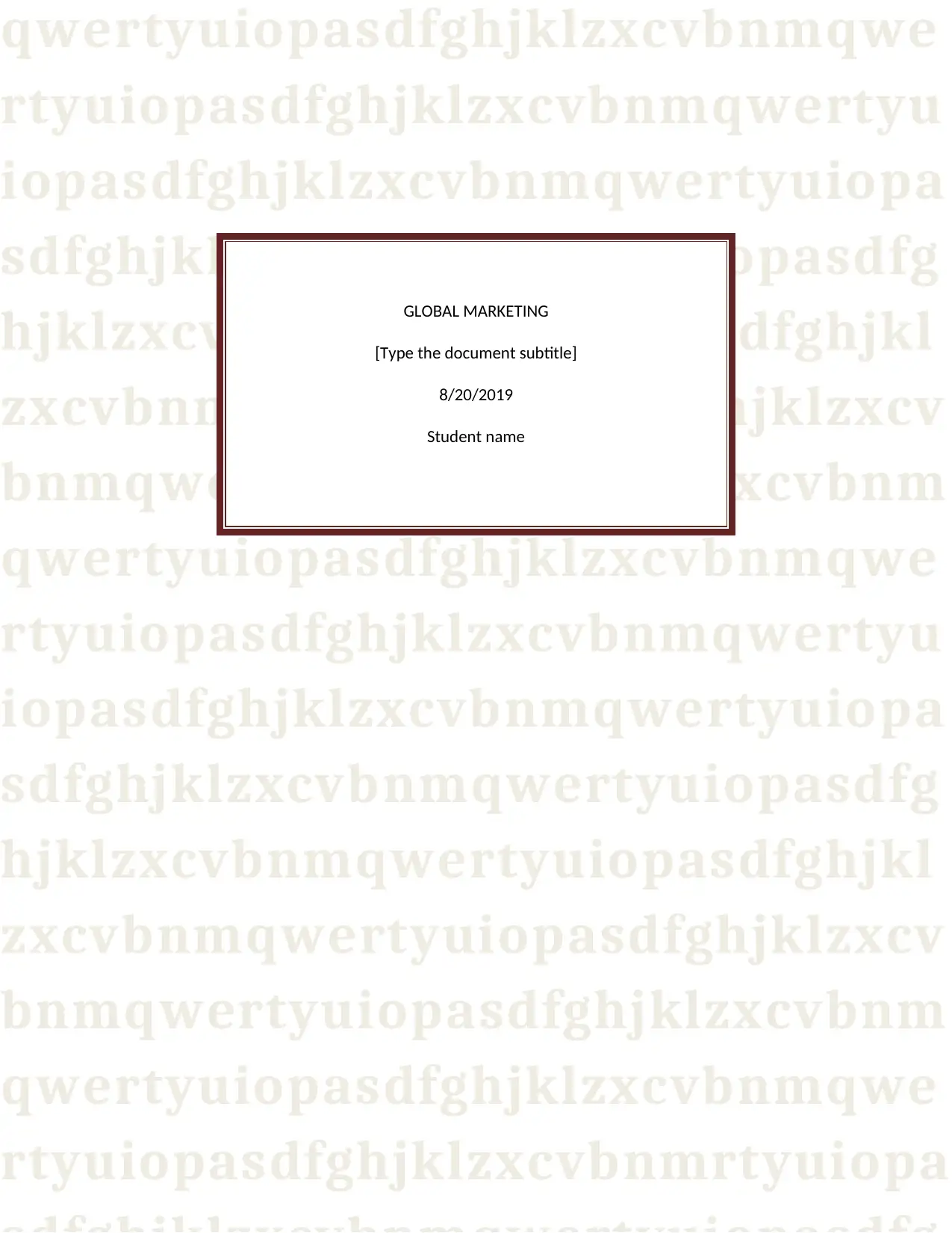
qwertyuiopasdfghjklzxcvbnmqwe
rtyuiopasdfghjklzxcvbnmqwertyu
iopasdfghjklzxcvbnmqwertyuiopa
sdfghjklzxcvbnmqwertyuiopasdfg
hjklzxcvbnmqwertyuiopasdfghjkl
zxcvbnmqwertyuiopasdfghjklzxcv
bnmqwertyuiopasdfghjklzxcvbnm
qwertyuiopasdfghjklzxcvbnmqwe
rtyuiopasdfghjklzxcvbnmqwertyu
iopasdfghjklzxcvbnmqwertyuiopa
sdfghjklzxcvbnmqwertyuiopasdfg
hjklzxcvbnmqwertyuiopasdfghjkl
zxcvbnmqwertyuiopasdfghjklzxcv
bnmqwertyuiopasdfghjklzxcvbnm
qwertyuiopasdfghjklzxcvbnmqwe
rtyuiopasdfghjklzxcvbnmrtyuiopa
GLOBAL MARKETING
[Type the document subtitle]
8/20/2019
Student name
rtyuiopasdfghjklzxcvbnmqwertyu
iopasdfghjklzxcvbnmqwertyuiopa
sdfghjklzxcvbnmqwertyuiopasdfg
hjklzxcvbnmqwertyuiopasdfghjkl
zxcvbnmqwertyuiopasdfghjklzxcv
bnmqwertyuiopasdfghjklzxcvbnm
qwertyuiopasdfghjklzxcvbnmqwe
rtyuiopasdfghjklzxcvbnmqwertyu
iopasdfghjklzxcvbnmqwertyuiopa
sdfghjklzxcvbnmqwertyuiopasdfg
hjklzxcvbnmqwertyuiopasdfghjkl
zxcvbnmqwertyuiopasdfghjklzxcv
bnmqwertyuiopasdfghjklzxcvbnm
qwertyuiopasdfghjklzxcvbnmqwe
rtyuiopasdfghjklzxcvbnmrtyuiopa
GLOBAL MARKETING
[Type the document subtitle]
8/20/2019
Student name
Paraphrase This Document
Need a fresh take? Get an instant paraphrase of this document with our AI Paraphraser
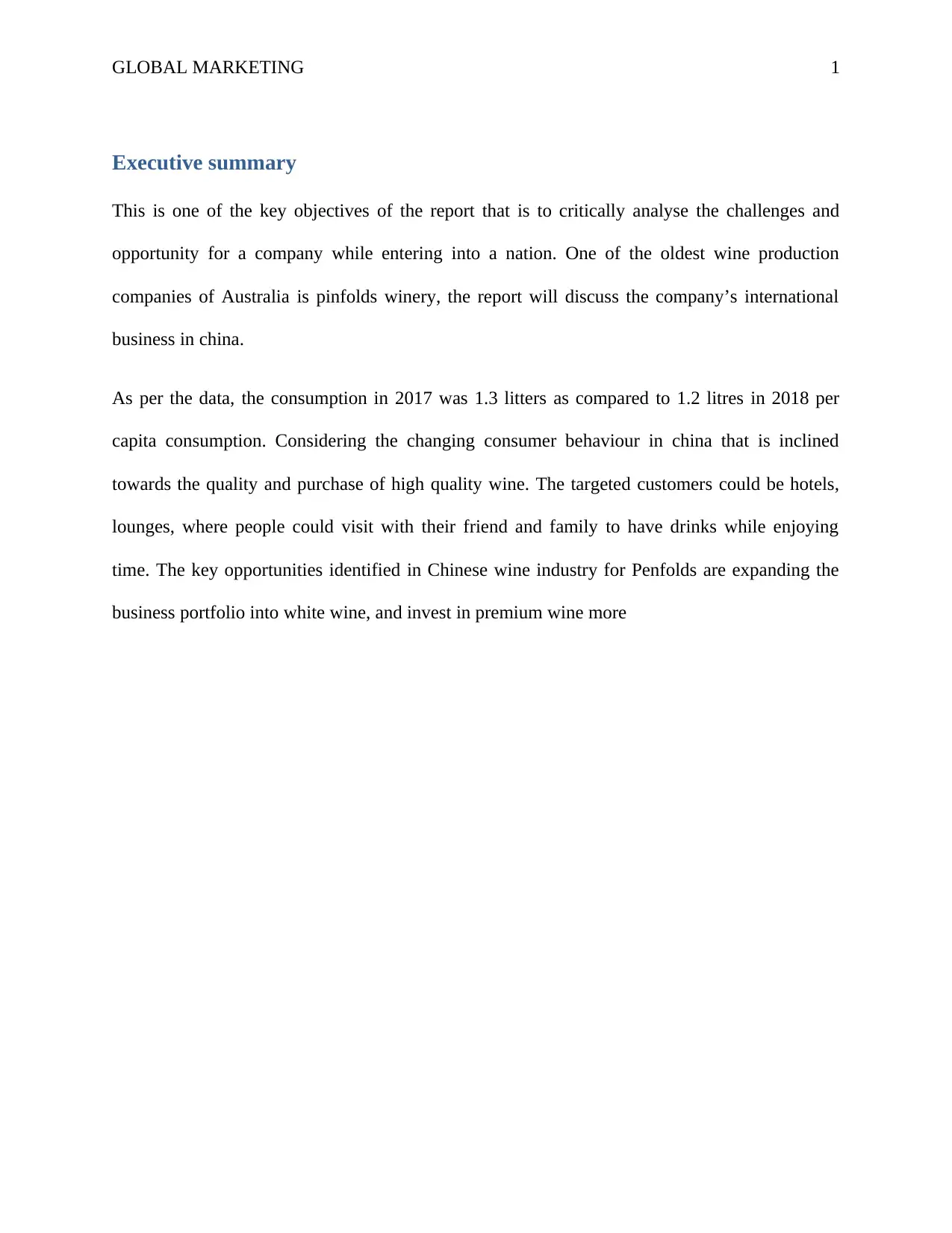
GLOBAL MARKETING 1
Executive summary
This is one of the key objectives of the report that is to critically analyse the challenges and
opportunity for a company while entering into a nation. One of the oldest wine production
companies of Australia is pinfolds winery, the report will discuss the company’s international
business in china.
As per the data, the consumption in 2017 was 1.3 litters as compared to 1.2 litres in 2018 per
capita consumption. Considering the changing consumer behaviour in china that is inclined
towards the quality and purchase of high quality wine. The targeted customers could be hotels,
lounges, where people could visit with their friend and family to have drinks while enjoying
time. The key opportunities identified in Chinese wine industry for Penfolds are expanding the
business portfolio into white wine, and invest in premium wine more
Executive summary
This is one of the key objectives of the report that is to critically analyse the challenges and
opportunity for a company while entering into a nation. One of the oldest wine production
companies of Australia is pinfolds winery, the report will discuss the company’s international
business in china.
As per the data, the consumption in 2017 was 1.3 litters as compared to 1.2 litres in 2018 per
capita consumption. Considering the changing consumer behaviour in china that is inclined
towards the quality and purchase of high quality wine. The targeted customers could be hotels,
lounges, where people could visit with their friend and family to have drinks while enjoying
time. The key opportunities identified in Chinese wine industry for Penfolds are expanding the
business portfolio into white wine, and invest in premium wine more
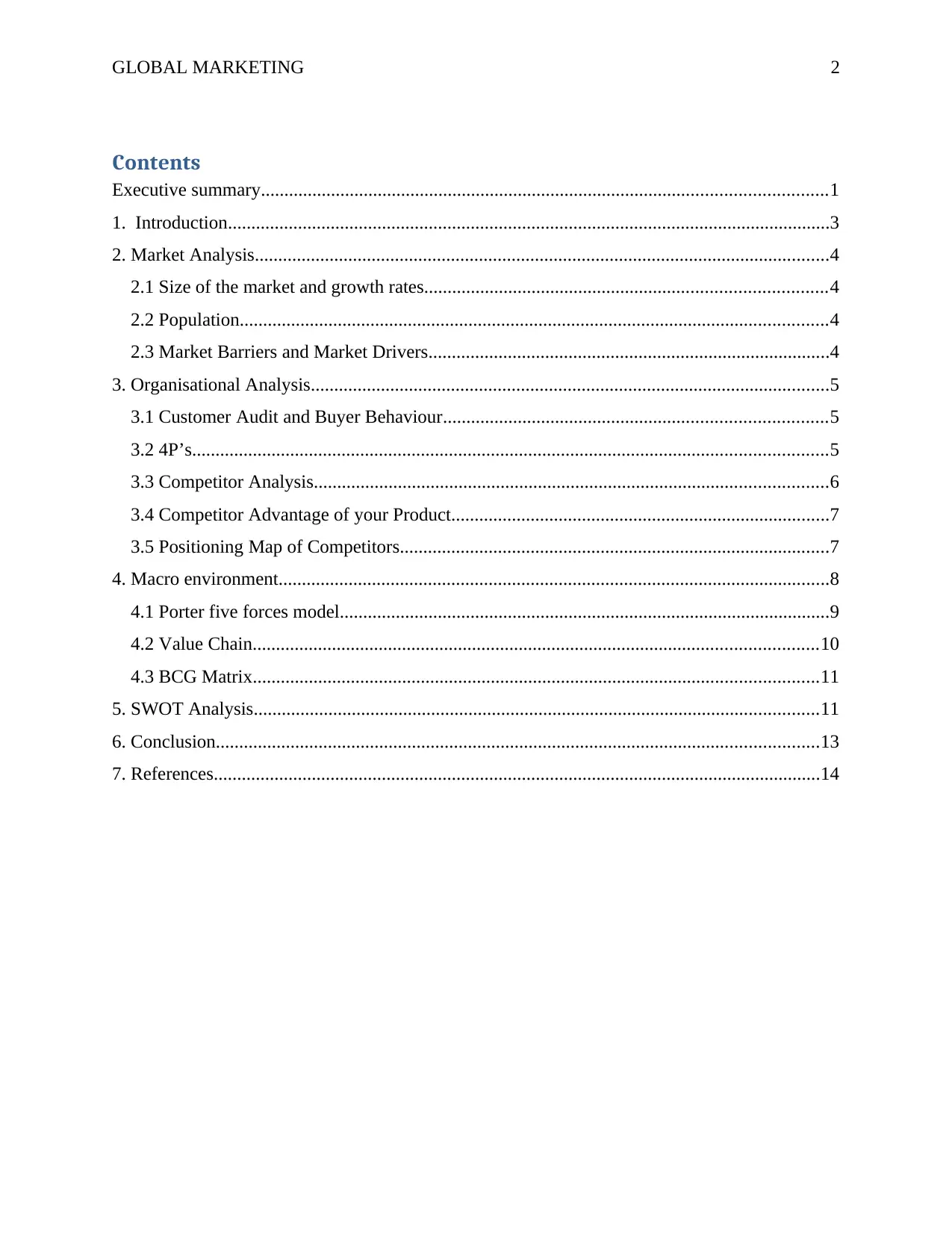
GLOBAL MARKETING 2
Contents
Executive summary.........................................................................................................................1
1. Introduction.................................................................................................................................3
2. Market Analysis...........................................................................................................................4
2.1 Size of the market and growth rates......................................................................................4
2.2 Population..............................................................................................................................4
2.3 Market Barriers and Market Drivers......................................................................................4
3. Organisational Analysis...............................................................................................................5
3.1 Customer Audit and Buyer Behaviour..................................................................................5
3.2 4P’s........................................................................................................................................5
3.3 Competitor Analysis..............................................................................................................6
3.4 Competitor Advantage of your Product.................................................................................7
3.5 Positioning Map of Competitors............................................................................................7
4. Macro environment......................................................................................................................8
4.1 Porter five forces model.........................................................................................................9
4.2 Value Chain.........................................................................................................................10
4.3 BCG Matrix.........................................................................................................................11
5. SWOT Analysis.........................................................................................................................11
6. Conclusion.................................................................................................................................13
7. References..................................................................................................................................14
Contents
Executive summary.........................................................................................................................1
1. Introduction.................................................................................................................................3
2. Market Analysis...........................................................................................................................4
2.1 Size of the market and growth rates......................................................................................4
2.2 Population..............................................................................................................................4
2.3 Market Barriers and Market Drivers......................................................................................4
3. Organisational Analysis...............................................................................................................5
3.1 Customer Audit and Buyer Behaviour..................................................................................5
3.2 4P’s........................................................................................................................................5
3.3 Competitor Analysis..............................................................................................................6
3.4 Competitor Advantage of your Product.................................................................................7
3.5 Positioning Map of Competitors............................................................................................7
4. Macro environment......................................................................................................................8
4.1 Porter five forces model.........................................................................................................9
4.2 Value Chain.........................................................................................................................10
4.3 BCG Matrix.........................................................................................................................11
5. SWOT Analysis.........................................................................................................................11
6. Conclusion.................................................................................................................................13
7. References..................................................................................................................................14
⊘ This is a preview!⊘
Do you want full access?
Subscribe today to unlock all pages.

Trusted by 1+ million students worldwide
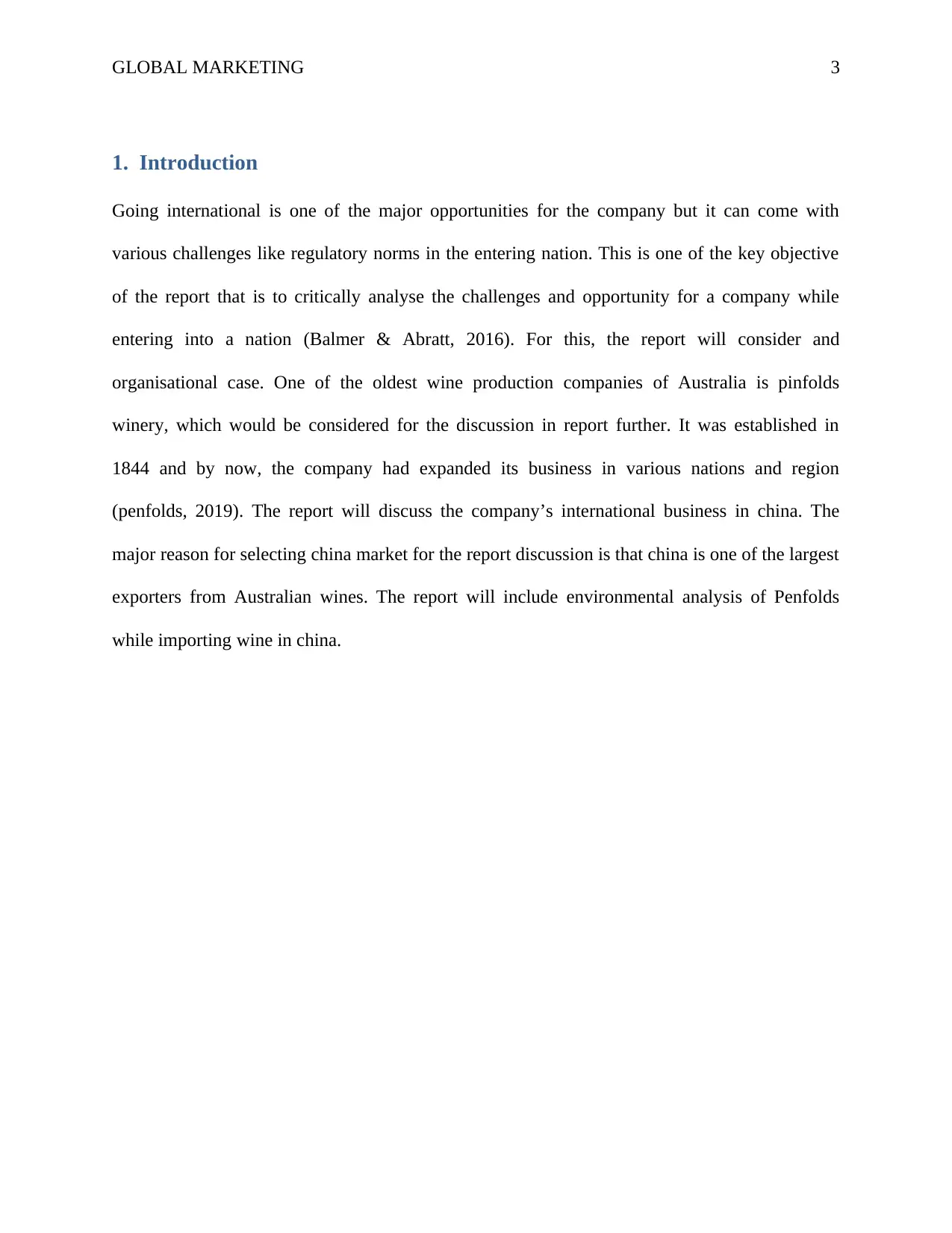
GLOBAL MARKETING 3
1. Introduction
Going international is one of the major opportunities for the company but it can come with
various challenges like regulatory norms in the entering nation. This is one of the key objective
of the report that is to critically analyse the challenges and opportunity for a company while
entering into a nation (Balmer & Abratt, 2016). For this, the report will consider and
organisational case. One of the oldest wine production companies of Australia is pinfolds
winery, which would be considered for the discussion in report further. It was established in
1844 and by now, the company had expanded its business in various nations and region
(penfolds, 2019). The report will discuss the company’s international business in china. The
major reason for selecting china market for the report discussion is that china is one of the largest
exporters from Australian wines. The report will include environmental analysis of Penfolds
while importing wine in china.
1. Introduction
Going international is one of the major opportunities for the company but it can come with
various challenges like regulatory norms in the entering nation. This is one of the key objective
of the report that is to critically analyse the challenges and opportunity for a company while
entering into a nation (Balmer & Abratt, 2016). For this, the report will consider and
organisational case. One of the oldest wine production companies of Australia is pinfolds
winery, which would be considered for the discussion in report further. It was established in
1844 and by now, the company had expanded its business in various nations and region
(penfolds, 2019). The report will discuss the company’s international business in china. The
major reason for selecting china market for the report discussion is that china is one of the largest
exporters from Australian wines. The report will include environmental analysis of Penfolds
while importing wine in china.
Paraphrase This Document
Need a fresh take? Get an instant paraphrase of this document with our AI Paraphraser
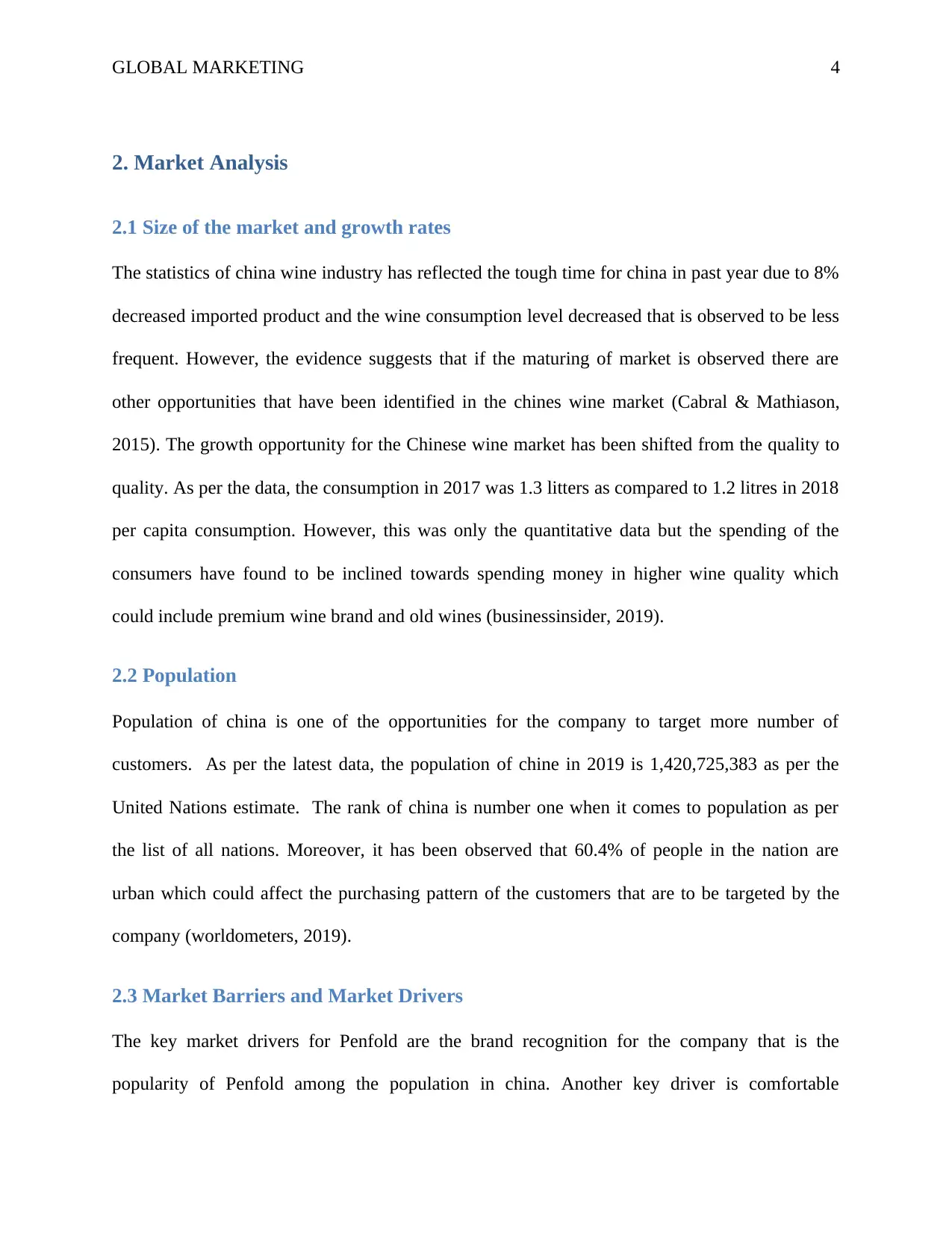
GLOBAL MARKETING 4
2. Market Analysis
2.1 Size of the market and growth rates
The statistics of china wine industry has reflected the tough time for china in past year due to 8%
decreased imported product and the wine consumption level decreased that is observed to be less
frequent. However, the evidence suggests that if the maturing of market is observed there are
other opportunities that have been identified in the chines wine market (Cabral & Mathiason,
2015). The growth opportunity for the Chinese wine market has been shifted from the quality to
quality. As per the data, the consumption in 2017 was 1.3 litters as compared to 1.2 litres in 2018
per capita consumption. However, this was only the quantitative data but the spending of the
consumers have found to be inclined towards spending money in higher wine quality which
could include premium wine brand and old wines (businessinsider, 2019).
2.2 Population
Population of china is one of the opportunities for the company to target more number of
customers. As per the latest data, the population of chine in 2019 is 1,420,725,383 as per the
United Nations estimate. The rank of china is number one when it comes to population as per
the list of all nations. Moreover, it has been observed that 60.4% of people in the nation are
urban which could affect the purchasing pattern of the customers that are to be targeted by the
company (worldometers, 2019).
2.3 Market Barriers and Market Drivers
The key market drivers for Penfold are the brand recognition for the company that is the
popularity of Penfold among the population in china. Another key driver is comfortable
2. Market Analysis
2.1 Size of the market and growth rates
The statistics of china wine industry has reflected the tough time for china in past year due to 8%
decreased imported product and the wine consumption level decreased that is observed to be less
frequent. However, the evidence suggests that if the maturing of market is observed there are
other opportunities that have been identified in the chines wine market (Cabral & Mathiason,
2015). The growth opportunity for the Chinese wine market has been shifted from the quality to
quality. As per the data, the consumption in 2017 was 1.3 litters as compared to 1.2 litres in 2018
per capita consumption. However, this was only the quantitative data but the spending of the
consumers have found to be inclined towards spending money in higher wine quality which
could include premium wine brand and old wines (businessinsider, 2019).
2.2 Population
Population of china is one of the opportunities for the company to target more number of
customers. As per the latest data, the population of chine in 2019 is 1,420,725,383 as per the
United Nations estimate. The rank of china is number one when it comes to population as per
the list of all nations. Moreover, it has been observed that 60.4% of people in the nation are
urban which could affect the purchasing pattern of the customers that are to be targeted by the
company (worldometers, 2019).
2.3 Market Barriers and Market Drivers
The key market drivers for Penfold are the brand recognition for the company that is the
popularity of Penfold among the population in china. Another key driver is comfortable
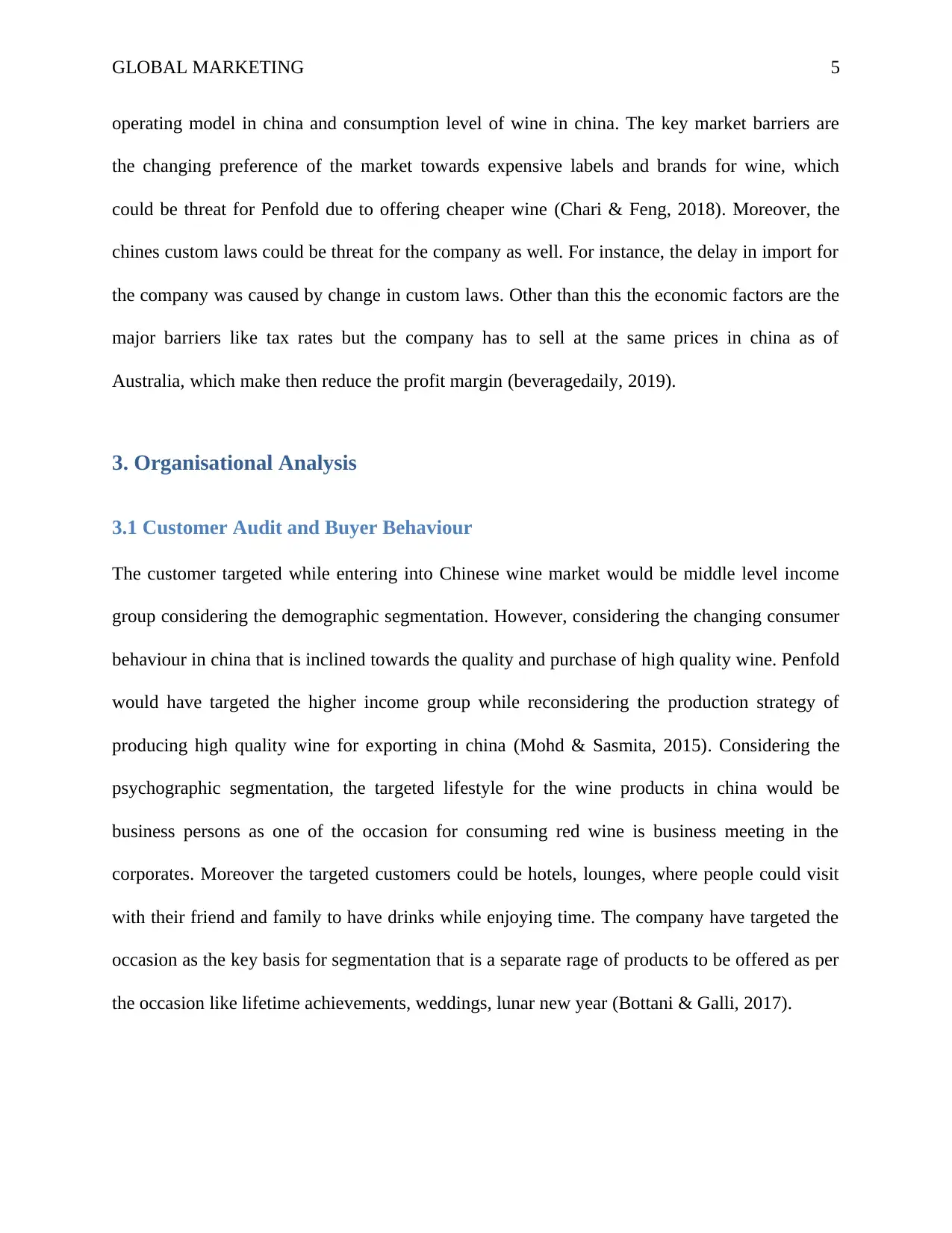
GLOBAL MARKETING 5
operating model in china and consumption level of wine in china. The key market barriers are
the changing preference of the market towards expensive labels and brands for wine, which
could be threat for Penfold due to offering cheaper wine (Chari & Feng, 2018). Moreover, the
chines custom laws could be threat for the company as well. For instance, the delay in import for
the company was caused by change in custom laws. Other than this the economic factors are the
major barriers like tax rates but the company has to sell at the same prices in china as of
Australia, which make then reduce the profit margin (beveragedaily, 2019).
3. Organisational Analysis
3.1 Customer Audit and Buyer Behaviour
The customer targeted while entering into Chinese wine market would be middle level income
group considering the demographic segmentation. However, considering the changing consumer
behaviour in china that is inclined towards the quality and purchase of high quality wine. Penfold
would have targeted the higher income group while reconsidering the production strategy of
producing high quality wine for exporting in china (Mohd & Sasmita, 2015). Considering the
psychographic segmentation, the targeted lifestyle for the wine products in china would be
business persons as one of the occasion for consuming red wine is business meeting in the
corporates. Moreover the targeted customers could be hotels, lounges, where people could visit
with their friend and family to have drinks while enjoying time. The company have targeted the
occasion as the key basis for segmentation that is a separate rage of products to be offered as per
the occasion like lifetime achievements, weddings, lunar new year (Bottani & Galli, 2017).
operating model in china and consumption level of wine in china. The key market barriers are
the changing preference of the market towards expensive labels and brands for wine, which
could be threat for Penfold due to offering cheaper wine (Chari & Feng, 2018). Moreover, the
chines custom laws could be threat for the company as well. For instance, the delay in import for
the company was caused by change in custom laws. Other than this the economic factors are the
major barriers like tax rates but the company has to sell at the same prices in china as of
Australia, which make then reduce the profit margin (beveragedaily, 2019).
3. Organisational Analysis
3.1 Customer Audit and Buyer Behaviour
The customer targeted while entering into Chinese wine market would be middle level income
group considering the demographic segmentation. However, considering the changing consumer
behaviour in china that is inclined towards the quality and purchase of high quality wine. Penfold
would have targeted the higher income group while reconsidering the production strategy of
producing high quality wine for exporting in china (Mohd & Sasmita, 2015). Considering the
psychographic segmentation, the targeted lifestyle for the wine products in china would be
business persons as one of the occasion for consuming red wine is business meeting in the
corporates. Moreover the targeted customers could be hotels, lounges, where people could visit
with their friend and family to have drinks while enjoying time. The company have targeted the
occasion as the key basis for segmentation that is a separate rage of products to be offered as per
the occasion like lifetime achievements, weddings, lunar new year (Bottani & Galli, 2017).
⊘ This is a preview!⊘
Do you want full access?
Subscribe today to unlock all pages.

Trusted by 1+ million students worldwide
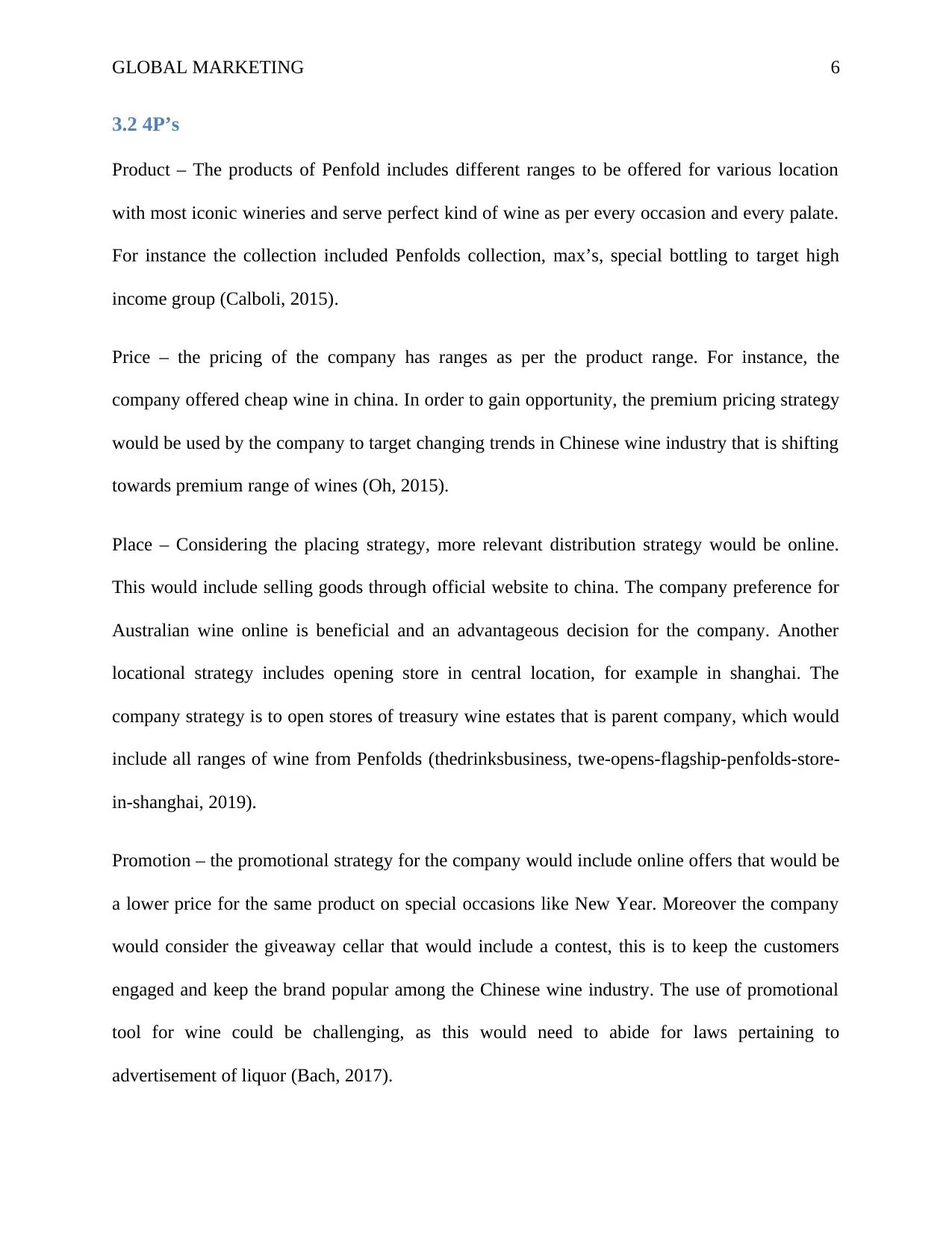
GLOBAL MARKETING 6
3.2 4P’s
Product – The products of Penfold includes different ranges to be offered for various location
with most iconic wineries and serve perfect kind of wine as per every occasion and every palate.
For instance the collection included Penfolds collection, max’s, special bottling to target high
income group (Calboli, 2015).
Price – the pricing of the company has ranges as per the product range. For instance, the
company offered cheap wine in china. In order to gain opportunity, the premium pricing strategy
would be used by the company to target changing trends in Chinese wine industry that is shifting
towards premium range of wines (Oh, 2015).
Place – Considering the placing strategy, more relevant distribution strategy would be online.
This would include selling goods through official website to china. The company preference for
Australian wine online is beneficial and an advantageous decision for the company. Another
locational strategy includes opening store in central location, for example in shanghai. The
company strategy is to open stores of treasury wine estates that is parent company, which would
include all ranges of wine from Penfolds (thedrinksbusiness, twe-opens-flagship-penfolds-store-
in-shanghai, 2019).
Promotion – the promotional strategy for the company would include online offers that would be
a lower price for the same product on special occasions like New Year. Moreover the company
would consider the giveaway cellar that would include a contest, this is to keep the customers
engaged and keep the brand popular among the Chinese wine industry. The use of promotional
tool for wine could be challenging, as this would need to abide for laws pertaining to
advertisement of liquor (Bach, 2017).
3.2 4P’s
Product – The products of Penfold includes different ranges to be offered for various location
with most iconic wineries and serve perfect kind of wine as per every occasion and every palate.
For instance the collection included Penfolds collection, max’s, special bottling to target high
income group (Calboli, 2015).
Price – the pricing of the company has ranges as per the product range. For instance, the
company offered cheap wine in china. In order to gain opportunity, the premium pricing strategy
would be used by the company to target changing trends in Chinese wine industry that is shifting
towards premium range of wines (Oh, 2015).
Place – Considering the placing strategy, more relevant distribution strategy would be online.
This would include selling goods through official website to china. The company preference for
Australian wine online is beneficial and an advantageous decision for the company. Another
locational strategy includes opening store in central location, for example in shanghai. The
company strategy is to open stores of treasury wine estates that is parent company, which would
include all ranges of wine from Penfolds (thedrinksbusiness, twe-opens-flagship-penfolds-store-
in-shanghai, 2019).
Promotion – the promotional strategy for the company would include online offers that would be
a lower price for the same product on special occasions like New Year. Moreover the company
would consider the giveaway cellar that would include a contest, this is to keep the customers
engaged and keep the brand popular among the Chinese wine industry. The use of promotional
tool for wine could be challenging, as this would need to abide for laws pertaining to
advertisement of liquor (Bach, 2017).
Paraphrase This Document
Need a fresh take? Get an instant paraphrase of this document with our AI Paraphraser
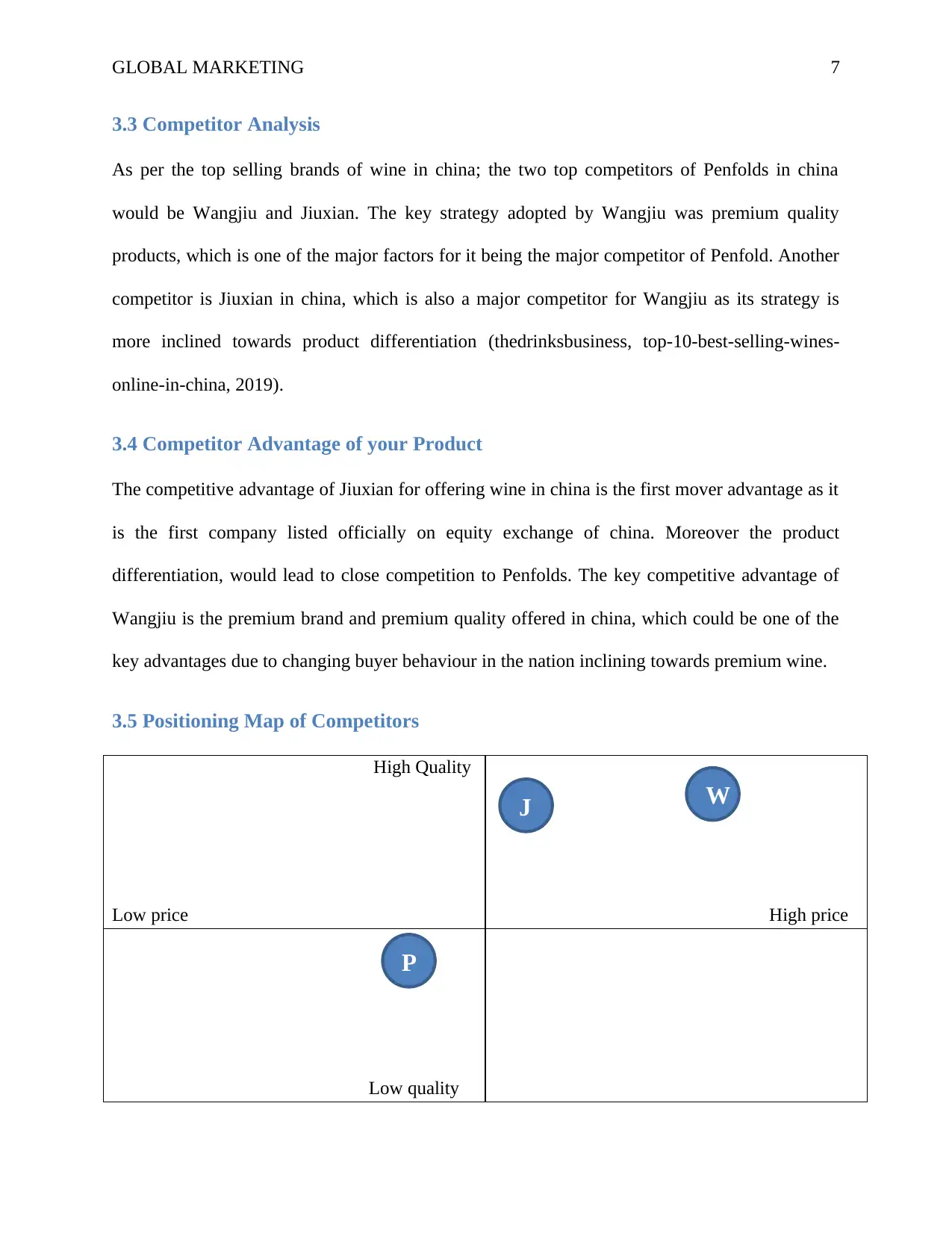
GLOBAL MARKETING 7
3.3 Competitor Analysis
As per the top selling brands of wine in china; the two top competitors of Penfolds in china
would be Wangjiu and Jiuxian. The key strategy adopted by Wangjiu was premium quality
products, which is one of the major factors for it being the major competitor of Penfold. Another
competitor is Jiuxian in china, which is also a major competitor for Wangjiu as its strategy is
more inclined towards product differentiation (thedrinksbusiness, top-10-best-selling-wines-
online-in-china, 2019).
3.4 Competitor Advantage of your Product
The competitive advantage of Jiuxian for offering wine in china is the first mover advantage as it
is the first company listed officially on equity exchange of china. Moreover the product
differentiation, would lead to close competition to Penfolds. The key competitive advantage of
Wangjiu is the premium brand and premium quality offered in china, which could be one of the
key advantages due to changing buyer behaviour in the nation inclining towards premium wine.
3.5 Positioning Map of Competitors
High Quality
Low price High price
Low quality
W
P
J
3.3 Competitor Analysis
As per the top selling brands of wine in china; the two top competitors of Penfolds in china
would be Wangjiu and Jiuxian. The key strategy adopted by Wangjiu was premium quality
products, which is one of the major factors for it being the major competitor of Penfold. Another
competitor is Jiuxian in china, which is also a major competitor for Wangjiu as its strategy is
more inclined towards product differentiation (thedrinksbusiness, top-10-best-selling-wines-
online-in-china, 2019).
3.4 Competitor Advantage of your Product
The competitive advantage of Jiuxian for offering wine in china is the first mover advantage as it
is the first company listed officially on equity exchange of china. Moreover the product
differentiation, would lead to close competition to Penfolds. The key competitive advantage of
Wangjiu is the premium brand and premium quality offered in china, which could be one of the
key advantages due to changing buyer behaviour in the nation inclining towards premium wine.
3.5 Positioning Map of Competitors
High Quality
Low price High price
Low quality
W
P
J
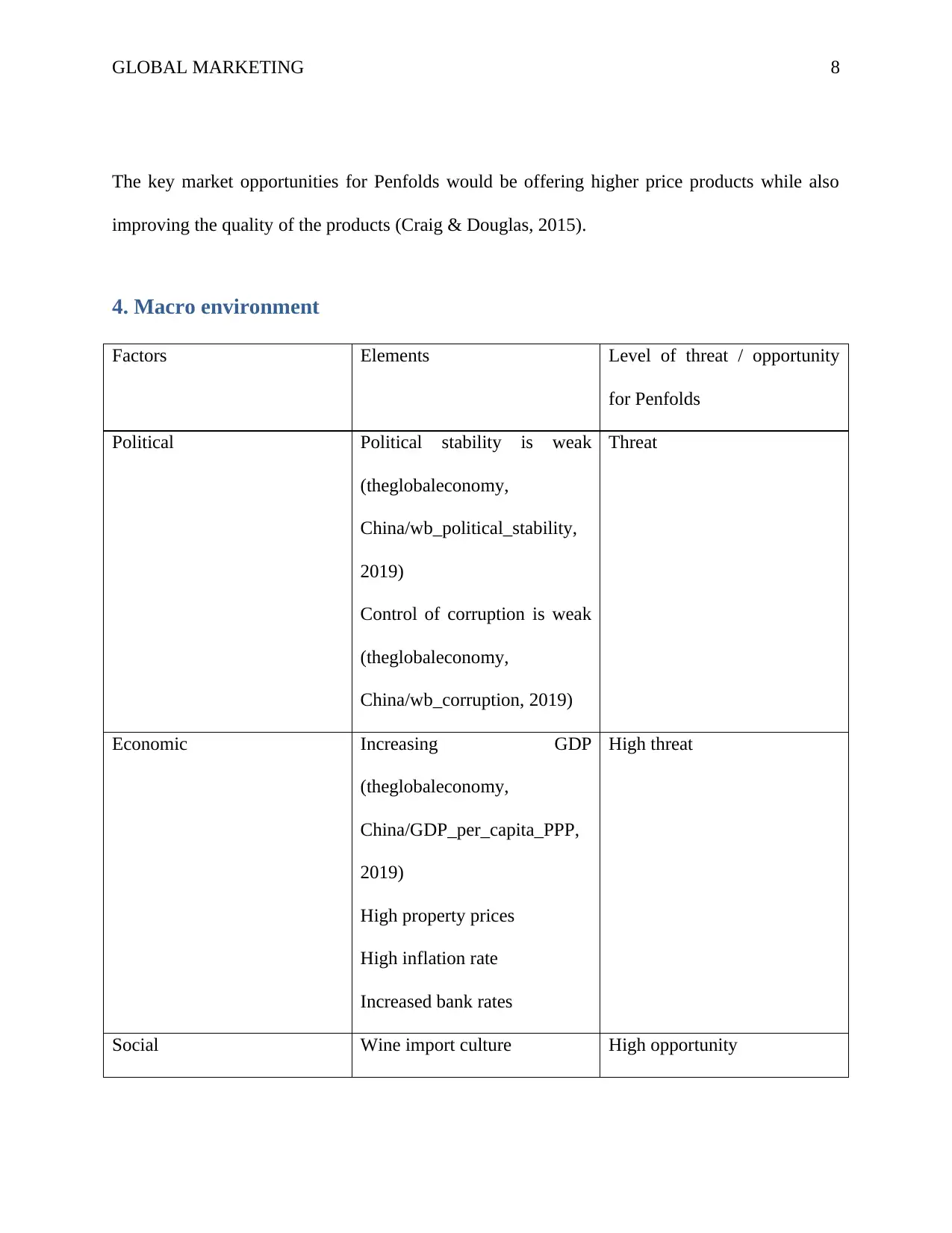
GLOBAL MARKETING 8
The key market opportunities for Penfolds would be offering higher price products while also
improving the quality of the products (Craig & Douglas, 2015).
4. Macro environment
Factors Elements Level of threat / opportunity
for Penfolds
Political Political stability is weak
(theglobaleconomy,
China/wb_political_stability,
2019)
Control of corruption is weak
(theglobaleconomy,
China/wb_corruption, 2019)
Threat
Economic Increasing GDP
(theglobaleconomy,
China/GDP_per_capita_PPP,
2019)
High property prices
High inflation rate
Increased bank rates
High threat
Social Wine import culture High opportunity
The key market opportunities for Penfolds would be offering higher price products while also
improving the quality of the products (Craig & Douglas, 2015).
4. Macro environment
Factors Elements Level of threat / opportunity
for Penfolds
Political Political stability is weak
(theglobaleconomy,
China/wb_political_stability,
2019)
Control of corruption is weak
(theglobaleconomy,
China/wb_corruption, 2019)
Threat
Economic Increasing GDP
(theglobaleconomy,
China/GDP_per_capita_PPP,
2019)
High property prices
High inflation rate
Increased bank rates
High threat
Social Wine import culture High opportunity
⊘ This is a preview!⊘
Do you want full access?
Subscribe today to unlock all pages.

Trusted by 1+ million students worldwide
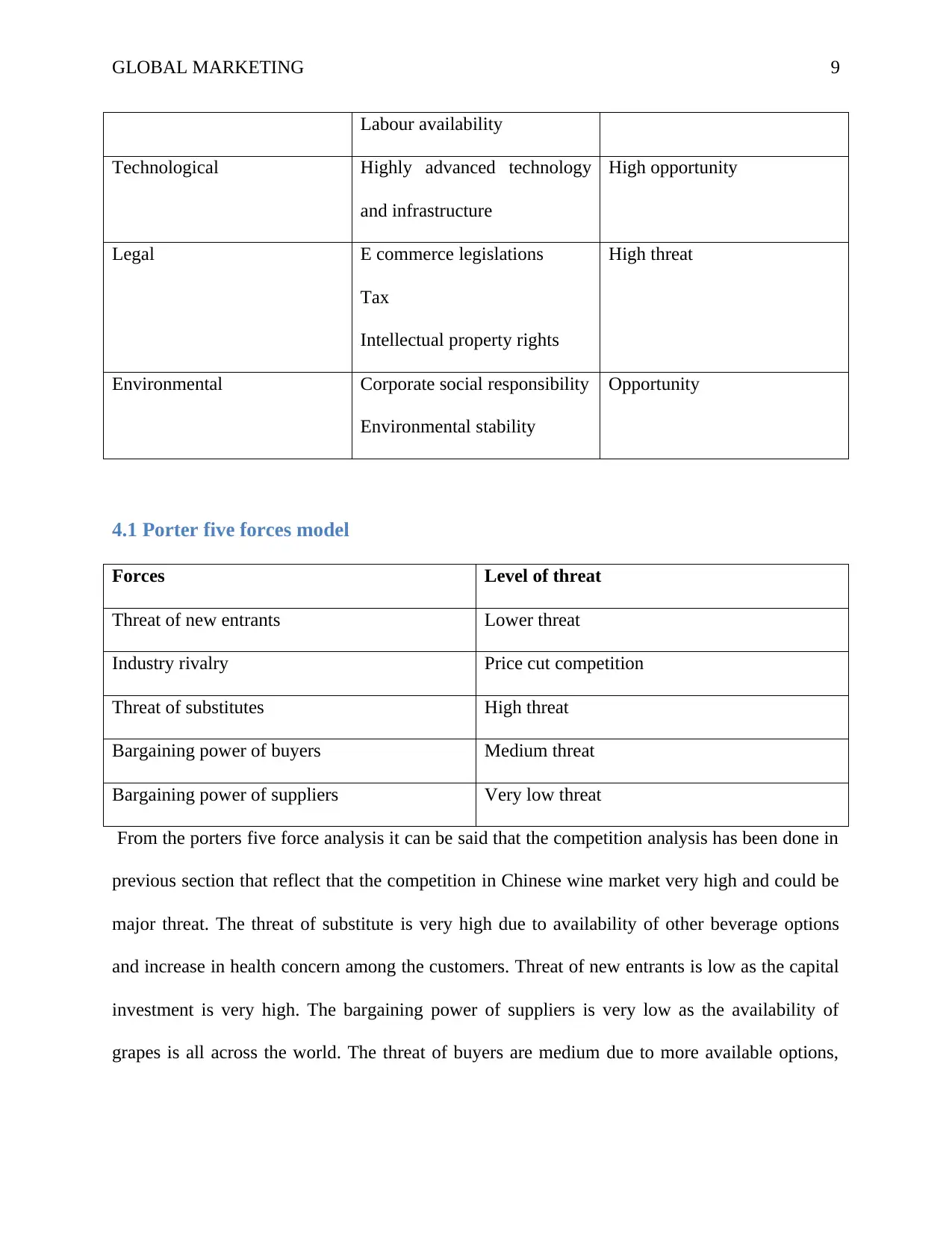
GLOBAL MARKETING 9
Labour availability
Technological Highly advanced technology
and infrastructure
High opportunity
Legal E commerce legislations
Tax
Intellectual property rights
High threat
Environmental Corporate social responsibility
Environmental stability
Opportunity
4.1 Porter five forces model
Forces Level of threat
Threat of new entrants Lower threat
Industry rivalry Price cut competition
Threat of substitutes High threat
Bargaining power of buyers Medium threat
Bargaining power of suppliers Very low threat
From the porters five force analysis it can be said that the competition analysis has been done in
previous section that reflect that the competition in Chinese wine market very high and could be
major threat. The threat of substitute is very high due to availability of other beverage options
and increase in health concern among the customers. Threat of new entrants is low as the capital
investment is very high. The bargaining power of suppliers is very low as the availability of
grapes is all across the world. The threat of buyers are medium due to more available options,
Labour availability
Technological Highly advanced technology
and infrastructure
High opportunity
Legal E commerce legislations
Tax
Intellectual property rights
High threat
Environmental Corporate social responsibility
Environmental stability
Opportunity
4.1 Porter five forces model
Forces Level of threat
Threat of new entrants Lower threat
Industry rivalry Price cut competition
Threat of substitutes High threat
Bargaining power of buyers Medium threat
Bargaining power of suppliers Very low threat
From the porters five force analysis it can be said that the competition analysis has been done in
previous section that reflect that the competition in Chinese wine market very high and could be
major threat. The threat of substitute is very high due to availability of other beverage options
and increase in health concern among the customers. Threat of new entrants is low as the capital
investment is very high. The bargaining power of suppliers is very low as the availability of
grapes is all across the world. The threat of buyers are medium due to more available options,
Paraphrase This Document
Need a fresh take? Get an instant paraphrase of this document with our AI Paraphraser
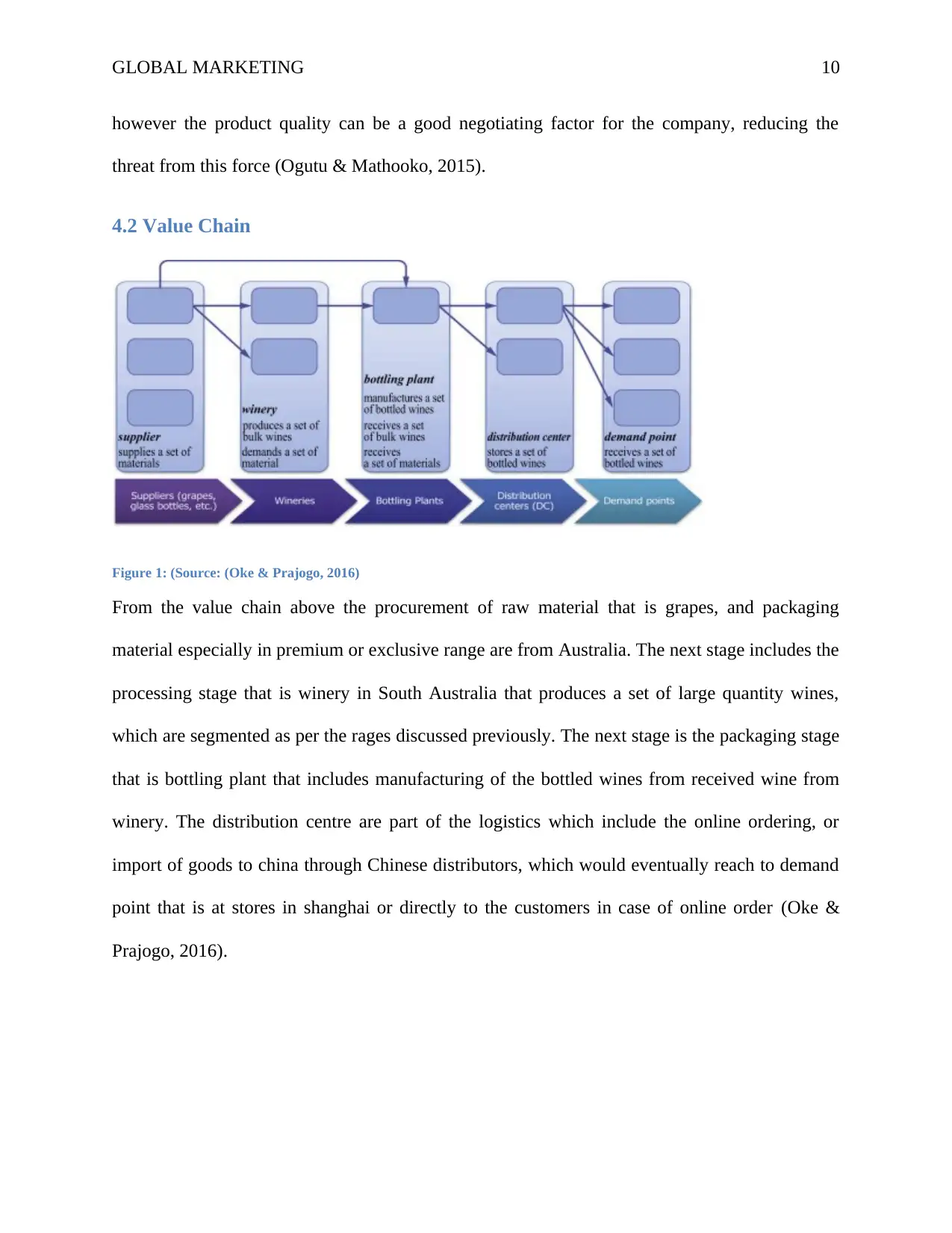
GLOBAL MARKETING 10
however the product quality can be a good negotiating factor for the company, reducing the
threat from this force (Ogutu & Mathooko, 2015).
4.2 Value Chain
Figure 1: (Source: (Oke & Prajogo, 2016)
From the value chain above the procurement of raw material that is grapes, and packaging
material especially in premium or exclusive range are from Australia. The next stage includes the
processing stage that is winery in South Australia that produces a set of large quantity wines,
which are segmented as per the rages discussed previously. The next stage is the packaging stage
that is bottling plant that includes manufacturing of the bottled wines from received wine from
winery. The distribution centre are part of the logistics which include the online ordering, or
import of goods to china through Chinese distributors, which would eventually reach to demand
point that is at stores in shanghai or directly to the customers in case of online order (Oke &
Prajogo, 2016).
however the product quality can be a good negotiating factor for the company, reducing the
threat from this force (Ogutu & Mathooko, 2015).
4.2 Value Chain
Figure 1: (Source: (Oke & Prajogo, 2016)
From the value chain above the procurement of raw material that is grapes, and packaging
material especially in premium or exclusive range are from Australia. The next stage includes the
processing stage that is winery in South Australia that produces a set of large quantity wines,
which are segmented as per the rages discussed previously. The next stage is the packaging stage
that is bottling plant that includes manufacturing of the bottled wines from received wine from
winery. The distribution centre are part of the logistics which include the online ordering, or
import of goods to china through Chinese distributors, which would eventually reach to demand
point that is at stores in shanghai or directly to the customers in case of online order (Oke &
Prajogo, 2016).
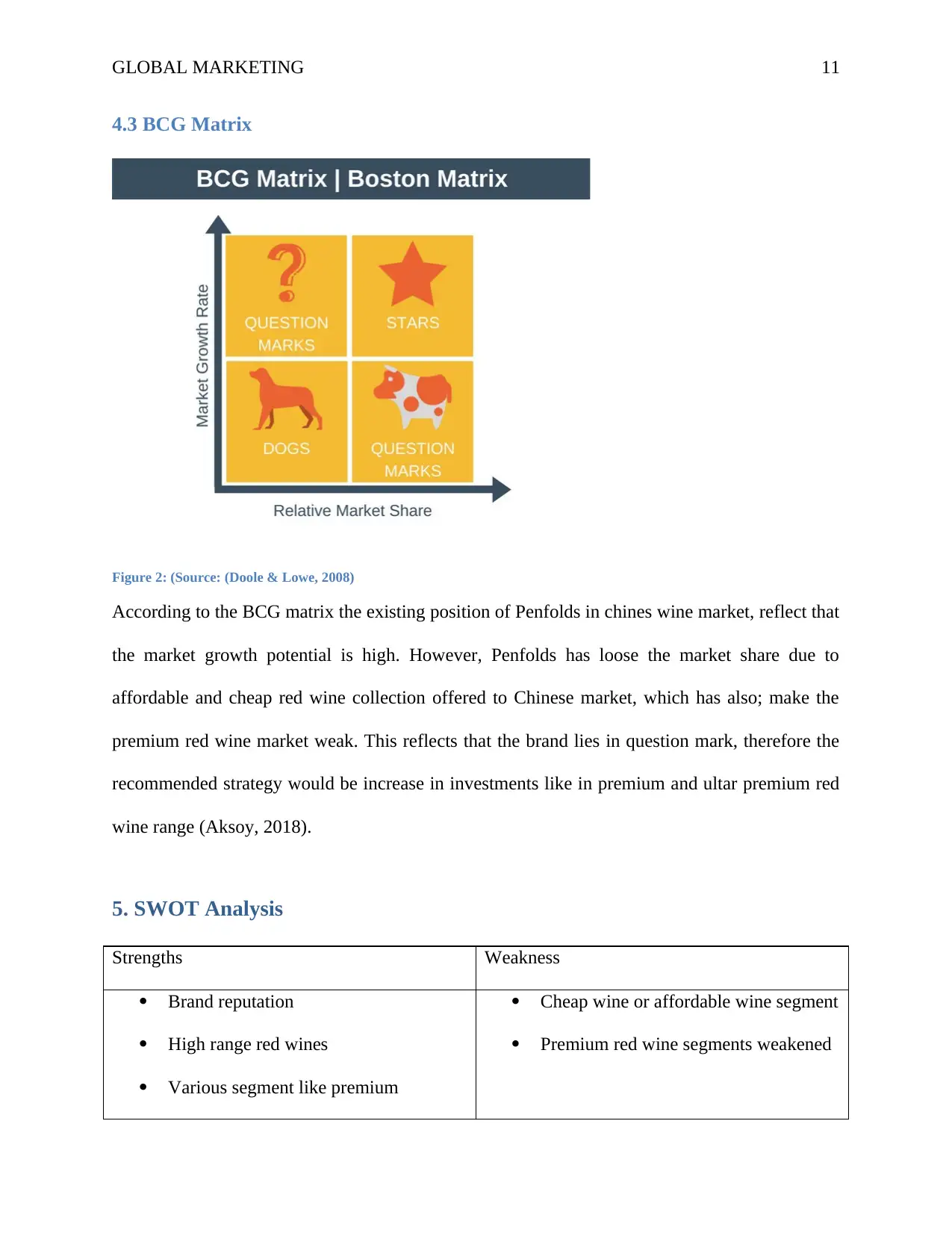
GLOBAL MARKETING 11
4.3 BCG Matrix
Figure 2: (Source: (Doole & Lowe, 2008)
According to the BCG matrix the existing position of Penfolds in chines wine market, reflect that
the market growth potential is high. However, Penfolds has loose the market share due to
affordable and cheap red wine collection offered to Chinese market, which has also; make the
premium red wine market weak. This reflects that the brand lies in question mark, therefore the
recommended strategy would be increase in investments like in premium and ultar premium red
wine range (Aksoy, 2018).
5. SWOT Analysis
Strengths Weakness
Brand reputation
High range red wines
Various segment like premium
Cheap wine or affordable wine segment
Premium red wine segments weakened
4.3 BCG Matrix
Figure 2: (Source: (Doole & Lowe, 2008)
According to the BCG matrix the existing position of Penfolds in chines wine market, reflect that
the market growth potential is high. However, Penfolds has loose the market share due to
affordable and cheap red wine collection offered to Chinese market, which has also; make the
premium red wine market weak. This reflects that the brand lies in question mark, therefore the
recommended strategy would be increase in investments like in premium and ultar premium red
wine range (Aksoy, 2018).
5. SWOT Analysis
Strengths Weakness
Brand reputation
High range red wines
Various segment like premium
Cheap wine or affordable wine segment
Premium red wine segments weakened
⊘ This is a preview!⊘
Do you want full access?
Subscribe today to unlock all pages.

Trusted by 1+ million students worldwide
1 out of 16
Related Documents
Your All-in-One AI-Powered Toolkit for Academic Success.
+13062052269
info@desklib.com
Available 24*7 on WhatsApp / Email
![[object Object]](/_next/static/media/star-bottom.7253800d.svg)
Unlock your academic potential
Copyright © 2020–2025 A2Z Services. All Rights Reserved. Developed and managed by ZUCOL.





